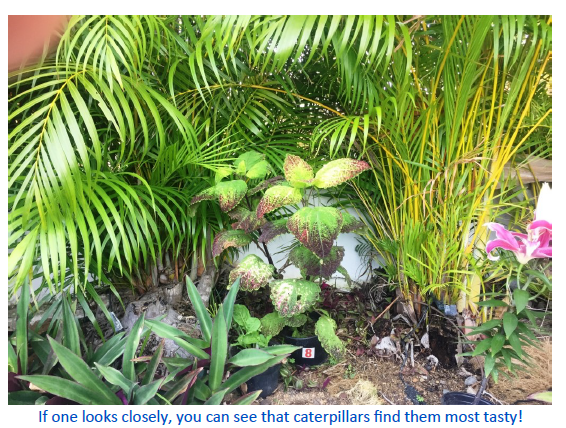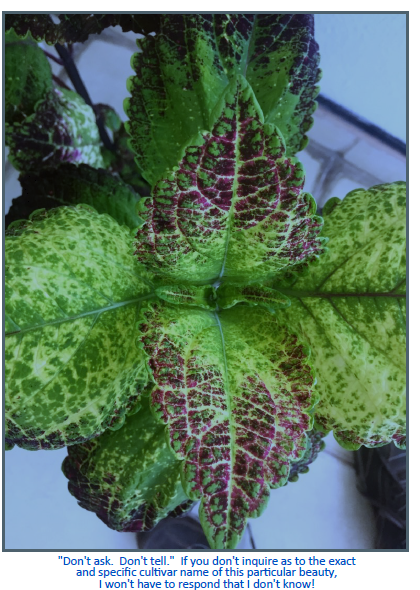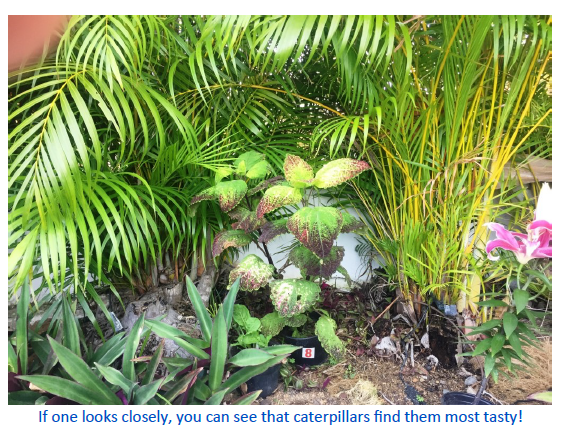By Tommy Clarkson on the May 2020 Edition
Solenostemon scutellarioides
Family Lamiaceae
Also known as Painted Nettle or Variegated Coleus
(Ladies and gentleman, meet the veritable poster child for wildly multi-colored, variegated tropical plant leaves!)
The subtitle for Nellie Neal’s book, Gardener’s Guide to Tropical Plants, is “Cool ways to add hot, bold foliage and striking textures.” Few if any combinations of words could more correctly describe the totality of favorable features regarding the whimsical leaves of the Coleus!
Zeroing, yet further, in on their hues, tints and shades, in an article she wrote for Parade, Julie Bawden Davis appropriately declared “Today’s coleuses come in a wide variety of stunning color combinations. You’ll find variegated leaves featuring deep purple edged in green, lime green coleus with a hint of burgundy and multi-colored selections displaying pink, green and even chartreuse.” Not to be outdone, Nellie exclaims, “Oh those leaves! They are green, red, yellow, purple cream and orange, in endless combinations, from splattered mosaics to neatly edged two-tones.” She exuberantly continues, “Coleus offers a plethora of round, oval, pointy, ruffled, cupped, curled and serrated leaf shapes. For bizarre, leafy, tropical excitement, nothing beats a modern coleus.”

While seeming to not be as enthusiastically excited about them as the preceding writers, in Tropical Plants for Home and Garden, William Warren calmly and succinctly says of the Solenostemon scutellarioides cultivars that they have been “developed into a highly varied and immensely decorative group of low-growing herbs or shrubs (which in some reference works now appears under the botanical name of Plectranthus.” Robert Lee Riffle is of similar thought, including Coleus within this group in his great tome, The Tropical Look, An Encyclopedia of Dramatic Landscape Plants.
Considering this beauty’s, purported, “dark side alias”according to the CABI Invasive Plant Compendium, “P. scutellarioides is. . . known to be invasive to Cuba . . . and a cultivation escape in Puerto Rico . . . Tonga and Guam. . . The species is considered a medicinal plant in many cultures but has also been classed as a narcotic hallucinogen . . . it currently appears to be a minor pest rather than a seriously damaging weed.” (This plant, bad? Personally, I’ve difficulty accepting any such manner of that!)
But, has there always been such an array as these for gardeners to enjoy? (Astute question that go to the head of the class!) Actually, in some genetic manner, shape or form, virtually all of today’s coleus varieties are rather recently created – genetic hybrid kin of Solenostemon scutellarioides (Say that three times fast!) which originated in Southeast Asia and the Malaysian peninsula.
My good friend, Dr. Arthur Whistler (who, as I write this, being the second case of the Coronavirus (COVID-19) in the State of Hawaii, is presently in an induced coma with a respirator in a Honolulu hospital) elaborated on the physical characteristic of today’s Coleus plants, in his A Guide to Tropical Ornamentals saying, (They are) distinguishable by their “four-angled stems, opposite. . . leaves (and) small, blue to purple, two-lipped flowers in whorls in racemes or panicles.” He continues, saying (there are) more than 200 cultivars named, having foliage de-scribed as antlered, parsley-leaved, fringed, fingered, or fern-leaved.”


Similar to its mint family relatives, the Coleus cultivars of today are of the green-stemmed, branching sort, often with inconsequential flowers. It’s advisable to deadhead these flowers immediately and pinch the stems back so as to encourage them to be more bushy.
These hybrids, generally, grow to an average height of two to four feet (60.96 – 121.92 cm) and spread of one to two feet (30.48 – 60.96 cm). They are not drought tolerant but, in turn, do not like to be inundated with water for more than an hour or two. And, while many Coleus varieties do best when sited in bright shade or dappled sunlight, as their delicate foliage can burn in direct sun, several new cultivars have been bred for their increased tolerance to sunlight.
According to Stirling Macoboy’s counsel, in Tropical Flowers and Plants, the “Coleus should be pinched back to force branching and be fed regularly with a high nitrogen fertilizer.” (I‘d encourage this be done monthly.) He also advises that one may choose to “Remove the mauve flowers as they develop to endure continual growth.”
Now cultivated pantropically (appearing in tropical regions on all major continents.) its natural enemies are mealybugs, aphids and caterpillars the latter of which, I noted a few moments ago, had noticed my turned back and begun to chow down on the leaves of one of mine!
The full edition or view it online
—
Tommy Clarkson is a bit of a renaissance man. He’s lived and worked in locales as disparate as the 1.2 square mile island of Kwajalein to war-torn Iraq, from aboard he and Patty’s boat berthed out of Sea Bright, NJ to Thailand, Germany, Hawaii and Viet Nam; He’s taught classes and courses on creative writing and mass communications from the elementary grades to graduate level; He’s spoken to a wide array of meetings, conferences and assemblages on topics as varied as Buddhism, strategic marketing and tropical plants; In the latter category he and Patty’s recently book, “The Civilized Jungle” – written for the lay gardener – has been heralded as “the best tropical plant book in the last ten years”; And, according to Trip Advisor, their spectacular tropical creation – Ola Brisa Gardens – is the “Number One Tour destination in Manzanillo”.




